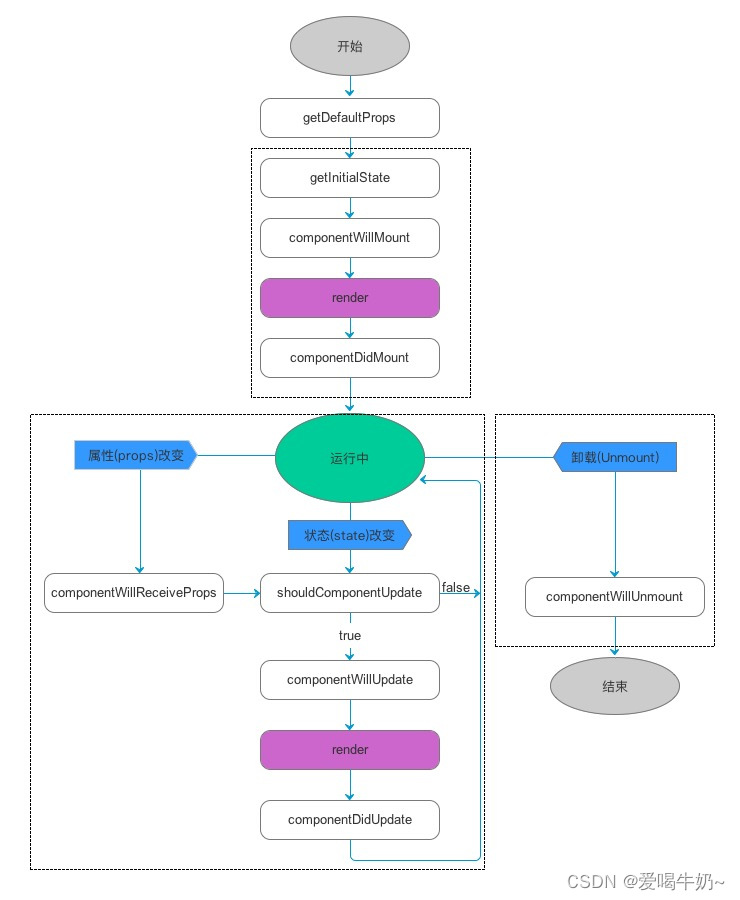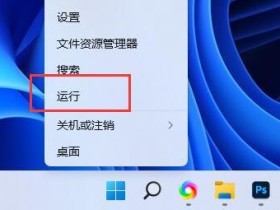目录
- **componentWillReceiveProps** :
一、React表单与事件
1、React表单组件
在HTML中,表单元素与其他元素最大的不同是它自带值或数据
而且,只要是有表单出现的地方,就会有用户输入,表单事件触发,就会涉及的数据处理。
在我们用React开发应用时,为了更好地管理应用中的数据,响应用户的输入,编写组件的时候呢,我们就会运用到**受控组件与非受控组件**这两个概念。
React推荐我们在绝大多数情况下都使用受控组件。这样可以保证表单的数据在组件的state管理之下,而不是各自独立保有各自的数据。
(1)受控组件与非受控组件——笔试题
没有v-model,需要自己去实现
**受控组件**简单来说就是它的值由React进行管理,
而**非受控组件**的值则由原生DOM进行管理。
- 受控组件:==>双向
一般涉及到表单元素时我们才会使用这种分类方法。
受控组件的值由props或state传入给受控组件(表单的输入框),用户在元素上交互或输入内容会引起应用state的改变。
在state改变之后重新渲染组件,我们才能在页面中看到元素中值的变化,
假如组件没有绑定事件处理函数改变state,用户的输入是不会起到任何效果的,这也就是“受控”的含义所在。
- 非受控组件:==>单向
类似于传统的DOM表单控件,用户输入不会直接引起应用state的变化,我们也不会直接为非受控组件传入值。
想要获取非受控组件,我们需要使用一个特殊的ref属性,同样也可以使用defaultValue属性来为其指定一次性的默认值。
示例如下:
import React from "react"
class App extends React.Component {
constructor(arg) {
super(arg)
this.state = {}
this.handleChange = (e) => {
this.setState({ value: e.target.value });
// e.target.value就是输入的值
}
}
render() {
return (
<div>
{/* 1、受控组件 */}
<input type='text' value={this.state.value} onChange={this.handleChange} />
{/* 2、非受控组件 */}
<input type="text" value={this.state.value} />
{/* 如果上没有onChange事件,输入框不能输入,value会一直是this.state.value */}
<input type="text" defaultValue="hello!" />
</div>
)
}
}
export default App(2)更多受控组件
在组件中声明表单元素(input_type/checked textarea select ……)时,一般都要为表单元素传入应用状态中的值,我们需要根据表单元素中用户的输入,对应用数据进行相应的操作和改变。
1、radio:
class MyApp extends React.Component {
constructor(props) {
super(props);
this.state = {
gender: ''
};
this.handleGender = this.handleGender.bind(this);
}
handleGender(event) {
this.setState({gender: event.target.value});
}
render() {
return (
<div>
<h2>input_checked 受控组件</h2>
<input type='radio' value="man" checked={this.state.gender=='man'} onChange={this.handleGender}/>男<br />
<input type='radio' value="woman" checked={this.state.gender=='woman'} onChange={this.handleGender}/>女<br />
<div>{this.state.gender}</div>
</div>
);
}
}
ReactDOM.render(
<MyApp />,
document.getElementById('root')
);2、mycheck:
import React, { Component } from 'react'
export default class Mycheck extends Component {
constructor(){
super()
this.state={
chengdu:true
}
this.chengduchange=(e)=>{
console.log(e.target.checked)
this.state.chengdu=e.target.checked
this.setState(this.state)
}
}
render() {
return (
<div>
<input type="checkbox" name='city' value="chengdu" checked={this.state.chengdu} onChange={this.chengduchange}/>
<input type="checkbox" name='city' value="shanghai"/>
<input type="checkbox" name='city' value="beijing"/>
<input type="checkbox" name='city' value="tianjing"/>
</div>
)
}
}
3、mydata
import React, { Component } from 'react'
export default class Mydate extends Component {
constructor(){
super()
this.state={
v:"2021-11-11"
}
this.change1=(e)=>{
console.log(e.target.value)
this.state.v=e.target.value
this.setState(this.state)
}
}
render() {
return (
<div>
<input type="date" value={this.state.v} onChange={this.change1}/>
</div>
)
}
}
4、myfile
import React, { Component } from 'react'
export default class Myfile extends Component {
constructor(){
super()
this.state={
v:""
}
this.change1=(e)=>{
console.log(e.target.files[0])
this.state.v=e.target.files[0]
this.setState(this.state)
}
}
render() {
return (
<div>
<input type="file" onChange={this.change1}/>
</div>
)
}
}
5、myselect
import React, { Component } from 'react'
export default class Myselect extends Component {
constructor(){
super()
this.state={
v:"beijing"
}
this.change1=(e)=>{
console.log(e.target.value)
this.state.v=e.target.value
this.setState(this.state)
}
this.send=()=>{
console.log(this.state.v)
}
}
render() {
return (
<div>
<select name="city" value={this.state.v} onChange={this.change1}>
<option value="chengdu">成都</option>
<option value="beijing">北京</option>
<option value="shanghai">上海</option>
</select>
<button onClick={this.send}>发送</button>
</div>
)
}
}
7、mytext
import React, { Component } from 'react'
export default class Mytext extends Component {
constructor(arg){
super(arg)
this.state={msg:"66666"}
this.input1=(e)=>{
console.log(e.target.value)
this.state.msg=e.target.value
this.setState(this.state)
}
}
render() {
return (
<div>
<p>{this.state.msg}</p>
<input type="text" value={this.state.msg} onInput={this.input1} />
<input type="text" />
</div>
)
}
}
2、React事件
(1)事件类型
使用React元素处理事件与处理DOM元素上的事件非常相似。不过有一些语法上的差异:
- React事件使用**小驼峰命名法**,而不是全部小写命名。
- React事件使用JSX传递一个函数作为事件处理程序,而不是一个字符串。示例:
- 鼠标事件:onClick onDoubleClick onMouseDown
- 触摸事件:onTouchStart onTouchMove onTouchEnd
- 键盘事件:onKeyDown
- 剪切事件:onCopy onCut onPaste
- 表单事件:onChange onInput onSubmit
- 焦点事件:onFocus
- UI事件:onScroll
- 滚动事件:onWheel
(2)事件对象
构造函数:fun
- React对原生的事件系统也进行了封装,在React中的事件对象实际上是一个跨浏览器的**虚拟事件对象** ,它拥有和原生事件对象相同的属性和方法。
- 在react 中使用“return false” 无法阻止默认事件,只能通过事件对象调用“event.preventDefault() ”进行阻止
class ClickEvent extends React.Component {
constructor(props) {
super(props);
this.state = {
value: 'hello world'
};
//函数写法==> 方法1:
this.changeData = this.changeData.bind(this);
//方法2:
this.fm=()=>{}
}
//方法3:
changeData(event) {
//changeData函数也可以写在构造函数constructor内,写this.changeData都能调用到这个给函数
console.log(event)
this.setState({value: '萨瓦迪卡'});
}
fn(arg){}
//方法4:
fn1=function(){}
//方法5:
fn2=()=>{}
render() {
return (
<div>
<button onClick={this.changeData}>点击改变</button>
<h2>{this.state.value}</h2>
//方法6:因为react中函数不能写小括号,所以自己设计,去实现有小括号,传参
<button onClick={(e)=>{this.fn(100)}}>函数传参</button>
</div>
);
}
}(3)事件绑定——this为unde
事件处理函数内部使用this 关键词时其指向==>
class ClickEvent extends React.Component {
constructor(arg) {
super(arg)
this.changeData=function (){console.log(this);} //undefined
}
changeData() {
console.log(this);//undefined
}
render() {
return (
<div>
<button onClick={this.changeData}>点击改变</button>
</div>
);
}
}解决方法:
1、将函数写在constructor 内部,对事件处理函数bind 绑定this(官方推荐)
2、 每次事件绑定都对事件处理函数做bind 绑定
3、定义事件处理函数时使用箭头函数
<button onClick={e=>this.changeData.call(this)}>点击改变</button>当事件处理函数需要传参时:
<button onClick={this.changeData.bind(this,id)}>点击改变</button> //将changeData处理为有this <h2>{e=>this.changeData.call(id,event)}</h2> //又想传参又要处理this,就用call
import React, { Component } from 'react'
export default class App extends Component {
constructor() {
super()
this.fn = () => {
console.log(1111, this.state)
}
this.fn3 = function () {
console.log(333, this.state)
}.bind(this)
// this.state={}
}
fn2() {
console.log(2222, this.state)
}
fn4 = function () {
console.log(44444, this)
}
fn5 = () => {
console.log(555, this)
}
fn6(arg) {
console.log(arg)
}
fn7(id) {
console.log(id)
}
state = { msg: "hello", arr: [{ id: 123, title: "a" }, { id: 124, title: "bb" }] }
render() {
return (
<div>
<button onClick={this.fn}>btn</button>
<button onClick={this.fn2.bind(this)}>btn2</button>
<button onClick={this.fn3}>btn3</button>
<button onClick={this.fn4.bind(this)}>btn4</button>
{/* <button onClick={(e)=>{this.fn4(this,e)}}>btn4</button> */}
<p>{this.state.msg}</p>
<button onClick={this.fn5}>btn5</button>
<button onClick={(e) => { this.fn6(100) }}>btn6</button>
{
this.state.arr.map(el => (<div key={el.id}>
<p>{el.title}</p>
<button onClick={(e) => { this.fn7(el.id) }}>btn</button>
</div>))
}
</div>
)
}
}
二、React组件生命周期
render函数 在页面初次加载的时候,会运行;数据每改变一次,页面刷新的时候也会运行。
构造函数只会调用一次,从创建到销毁都只调用一次。
1、组件的生命周期
- Mounting:已插入真实 DOM
- Updating:正在被重新渲染
- Unmounting:已移出真实 DOM

-
组件创建阶段(初始加载):一辈子只执行一次 构造函数(有争议,因为构造函数不算生命周期函数)、componentWillMount: render: componentDidMount:
-
组件运行阶段:按需,根据props 属性或state 状态的改变,有选择性的执行0 到多次 componentWillReceiveProps: shouldComponentUpdate: componentWillUpdate: render: componentDidUpdate:
-
组件销毁阶段:一辈子只执行一次
-
因为没有了创建前后,想做预加载,就在构造函数或者componentWillMount中做
2、生命周期钩子详解
定义:在特定的阶段,你刚刚自动执行的函数(方法)
- **componentWillMount** :
在渲染前调用,在客户端也在服务端。
- **componentDidMount** :在**第一次渲染后**调用,只在客户端。之后组件已经生成了对应的DOM结构,可以通过this.getDOMNode()来进行访问。 如果你想和其他JavaScript框架一起使用,可以在这个方法中调用setTimeout, setInterval或者发送AJAX请求等操作(防止异部操作阻塞UI)。
- **componentWillReceiveProps** :在组件接收到一个新的 prop (更新后)时被调用。这个方法在初始化render时不会被调用。
- **shouldComponentUpdate** :自己判断是否需要刷新
返回一个布尔值。在组件接收到新的props或者state时被调用。在初始化时或者使用forceUpdate时不被调用。 可以在你确认不需要更新组件时使用。
- **componentWillUpdate**:准备更新
在组件接收到新的props或者state但还没有render时被调用。在初始化时不会被调用。
render函数 在这中间执行
- **componentDidUpdate** :已经更新,数据已经改完了
在组件完成更新后立即调用。在初始化时不会被调用。
- **componentWillUnmount**:即将销毁
在组件从 DOM 中移除的时候立刻被调用。
class MyApp extends React.Component {
constructor(props) {
super(props);
this.state = {
date: new Date()
};
}
//通过componentDidMount 方法设置一个定时器,每隔1秒重新设置时间,并重新渲染:
componentDidMount() {
var oThis=this;
clearInterval(this.timer);
this.timer=setInterval(function() {
oThis.setState({
date: new Date()
})
}, 1000)
}
render(){
return (
<h2>{this.state.date.toLocaleTimeString()}</h2>
);
}
}父组件的状态传递到子组件的属性中
class Content extends React.Component {
//在渲染前调用,在客户端也在服务端
componentWillMount() {
console.log('Component WILL MOUNT!')
}
//在第一次渲染后调用,只在客户端
componentDidMount() {
console.log('Component DID MOUNT!')
}
//在组件接收到一个新的 prop (更新后)时被调用
componentWillReceiveProps(newProps) {
console.log('Component WILL RECEIVE PROPS!')
}
//在组件接收到新的props或者state时被调用
shouldComponentUpdate(newProps, newState) {
return true;
}
//在组件接收到新的props或者state但还没有render时被调用
componentWillUpdate(nextProps, nextState) {
console.log('Component WILL UPDATE!');
}
//在组件完成更新后立即调用
componentDidUpdate(prevProps, prevState) {
console.log('Component DID UPDATE!')
}
//在组件从 DOM 中移除的时候立刻被调用
componentWillUnmount() {
console.log('Component WILL UNMOUNT!')
}
render() {
return (
<div>
<h3>{this.props.myNumber}</h3>
</div>
);
}
}
class MyApp extends React.Component {
constructor(props) {
super(props);
//声明状态
this.state = {
data: 0,
isRender: true
};
this.setNewNumber = this.setNewNumber.bind(this);
this.deleteDOM = this.deleteDOM.bind(this);
}
//改变状态值并传递到子组件
setNewNumber() {
this.setState({data: this.state.data + 1});
}
//删除子组件
deleteDOM() {
this.setState({isRender: false})
}
render() {
return (
<div>
<button onClick={this.setNewNumber}>点我改变状态</button>
<button onClick={this.deleteDOM}>点我删除子组件</button>
{ this.state.isRender ? <Content myNumber={this.state.data} /> : null }
</div>
);
}
}
ReactDOM.render(
<div>
<MyApp />
</div>,
document.getElementById('root')
);import React, { Component } from 'react'
export default class Box extends Component {
constructor() {
super()
this.state = {
count: 2,
token: "abcdqwe"
}
this.increment1 = function () {
this.setState({ count: this.state.count + 1 })
}
this.changetoken = function () {
this.setState({ token: "abcdqwe2" })
}
console.log("constructor")
}
render() {
console.log("render--box")
return (
<div>
<p>{this.state.count}</p>
<button onClick={this.increment1.bind(this)}>count++</button>
<button onClick={this.changetoken.bind(this)}>change_token</button>
</div>
)
}
componentWillMount() {
console.log("componentWillMount")
}
componentWillReceiveProps() {
console.log("componentWillReceiveProps")
}
componentDidMount() {
console.log("componentDidMount")
}
componentWillUpdate() {
console.log("componentWillUpdate")
}
shouldComponentUpdate() {
console.log("shouldComponentUpdate", arguments)
//只有传入的有count而是是新值 才更新
if (arguments[1].count && arguments[1].count != this.state.count) { return true }
else { return false }
}
componentDidUpdate() {
console.log("componentDidUpdate")
}
componentWillUnmount() {
console.log("componentWillUnmount")
}
}
3、生命周期钩子——网络请求
componentDidMount
import React, { Component } from 'react'
export default class Box2 extends Component {
state={
arr:[]
}
render() {
return (
<div>
<h1>box2</h1>
{
this.state.arr.map(el=><div>{el.title}----{el.age}</div>)
}
</div>
)
}
componentDidMount(){
fetch("http://192.168.6.78:7001/test").then(res=>res.json())
.then(data=>{
console.log(data)
this.state.arr=data
this.setState(this.state)
})
}
}







